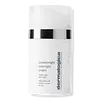What's inside
What's inside
 Key Ingredients
Key Ingredients

 Benefits
Benefits

 Concerns
Concerns

 Ingredients Side-by-side
Ingredients Side-by-side

Water
Skin ConditioningDimethicone
EmollientMethylheptyl Isostearate
Skin ConditioningButylene Glycol
HumectantNiacinamide
Smoothing1,2-Hexanediol
Skin ConditioningCetearyl Ethylhexanoate
EmollientCetyl Alcohol
EmollientIsohexadecane
EmollientCetearyl Alcohol
EmollientGlyceryl Stearate Citrate
EmollientRubus Idaeus Seed Oil
EmollientVaccinium Macrocarpon Seed Oil
Skin ConditioningHexylresorcinol
AntimicrobialLactobacillus/Pumpkin Ferment Extract
Skin ConditioningCananga Odorata Flower Oil
MaskingCitrus Aurantium Dulcis Peel Oil
MaskingCitrus Limon Peel Oil
MaskingPrunus Amygdalus Dulcis Oil
Skin ConditioningJuniperus Mexicana Oil
MaskingRosa Damascena Flower Oil
MaskingHydroxyacetophenone
AntioxidantDipotassium Glycyrrhizate
HumectantLactobacillus Ferment
Skin ConditioningPotassium Cetyl Phosphate
EmulsifyingHydrogenated Phosphatidylcholine
EmulsifyingPhytosterols
Skin ConditioningDimethicone Crosspolymer
Emulsion StabilisingAcrylates/C10-30 Alkyl Acrylate Crosspolymer
Emulsion StabilisingAminomethyl Propanol
BufferingGlyceryl Caprylate
EmollientPolysilicone-11
Tocopherol
AntioxidantTetrasodium Glutamate Diacetate
Zinc Glycinate
BufferingMagnesium Ascorbyl Phosphate
AntioxidantIsostearic Acid
CleansingBenzyl Benzoate
AntimicrobialDecyl Glucoside
CleansingBenzyl Salicylate
PerfumingSodium Hydroxide
BufferingSodium Glycolate
BufferingSodium Formate
BufferingDimethiconol
EmollientLimonene
PerfumingFarnesol
PerfumingWater, Dimethicone, Methylheptyl Isostearate, Butylene Glycol, Niacinamide, 1,2-Hexanediol, Cetearyl Ethylhexanoate, Cetyl Alcohol, Isohexadecane, Cetearyl Alcohol, Glyceryl Stearate Citrate, Rubus Idaeus Seed Oil, Vaccinium Macrocarpon Seed Oil, Hexylresorcinol, Lactobacillus/Pumpkin Ferment Extract, Cananga Odorata Flower Oil, Citrus Aurantium Dulcis Peel Oil, Citrus Limon Peel Oil, Prunus Amygdalus Dulcis Oil, Juniperus Mexicana Oil, Rosa Damascena Flower Oil, Hydroxyacetophenone, Dipotassium Glycyrrhizate, Lactobacillus Ferment, Potassium Cetyl Phosphate, Hydrogenated Phosphatidylcholine, Phytosterols, Dimethicone Crosspolymer, Acrylates/C10-30 Alkyl Acrylate Crosspolymer, Aminomethyl Propanol, Glyceryl Caprylate, Polysilicone-11, Tocopherol, Tetrasodium Glutamate Diacetate, Zinc Glycinate, Magnesium Ascorbyl Phosphate, Isostearic Acid, Benzyl Benzoate, Decyl Glucoside, Benzyl Salicylate, Sodium Hydroxide, Sodium Glycolate, Sodium Formate, Dimethiconol, Limonene, Farnesol
Water
Skin ConditioningPolysilicone-11
Squalane
EmollientPropanediol
SolventSodium Acrylates Crosspolymer-2
AbsorbentCetyl Alcohol
EmollientPotassium Cetyl Phosphate
EmulsifyingCurcuma Wenyujin/Curcuma Kwangsiensis Rhizome Extract
AntiseborrhoeicSodium Hyaluronate
HumectantGlycine Soja Germ Extract
EmollientLysine
Skin ConditioningProline
Skin ConditioningUrea
BufferingYeast Amino Acids
HumectantTrehalose
HumectantInositol
HumectantTaurine
BufferingBetaine
HumectantLactic Acid
BufferingMannose
HumectantPolyglyceryl-3 Laurate
EmulsifyingButylene Glycol
HumectantEthylhexylglycerin
Skin ConditioningSodium Mannose Phosphate
HumectantLaureth-12
EmulsifyingCI 77120
Cosmetic ColorantXanthan Gum
EmulsifyingTetrasodium Glutamate Diacetate
Sodium Carbonate
BufferingLeuconostoc/Radish Root Ferment Filtrate
AntimicrobialTocopherol
AntioxidantGlycerin
HumectantLauric Acid
CleansingPhenoxyethanol
PreservativeChlorphenesin
AntimicrobialDehydroacetic Acid
PreservativeCopper Sulfate
Skin ConditioningPotassium Sorbate
PreservativeWater, Polysilicone-11, Squalane, Propanediol, Sodium Acrylates Crosspolymer-2, Cetyl Alcohol, Potassium Cetyl Phosphate, Curcuma Wenyujin/Curcuma Kwangsiensis Rhizome Extract, Sodium Hyaluronate, Glycine Soja Germ Extract, Lysine, Proline, Urea, Yeast Amino Acids, Trehalose, Inositol, Taurine, Betaine, Lactic Acid, Mannose, Polyglyceryl-3 Laurate, Butylene Glycol, Ethylhexylglycerin, Sodium Mannose Phosphate, Laureth-12, CI 77120, Xanthan Gum, Tetrasodium Glutamate Diacetate, Sodium Carbonate, Leuconostoc/Radish Root Ferment Filtrate, Tocopherol, Glycerin, Lauric Acid, Phenoxyethanol, Chlorphenesin, Dehydroacetic Acid, Copper Sulfate, Potassium Sorbate
Alternatives
Ingredients Explained
These ingredients are found in both products.
Ingredients higher up in an ingredient list are typically present in a larger amount.
Butylene Glycol (or BG) is used within cosmetic products for a few different reasons:
Overall, Butylene Glycol is a safe and well-rounded ingredient that works well with other ingredients.
Though this ingredient works well with most skin types, some people with sensitive skin may experience a reaction such as allergic rashes, closed comedones, or itchiness.
Learn more about Butylene GlycolCetyl Alcohol is a fatty alcohol. Fatty Alcohols are most often used as an emollient or to thicken a product.
Its main roles are:
Though it has "alcohol" in the name, it is not related to denatured alcohol or ethyl alcohol.
The FDA allows products labeled "alcohol-free" to have fatty alcohols.
Learn more about Cetyl AlcoholPolysilicone-11 is a film-forming silicone that creates a non-tacky and matte finish on the skin. It's commonly used to improve texture, absorb excess oil, and help active ingredients spread evenly.
Due to its "rubber-like" structure, it stays on the skin's surface instead of being absorbed. On the skin, it creates a flexible layer that enhances wearability and stability.
Potassium Cetyl Phosphate is the potassium salt of a mixture. This mixture consists of the esters from phosphoricacid and cetyl alcohol.
Potassium Cetyl Phosphate is an emulsifier and cleansing agent. Emulsifiers help stabilize a product. It does this by preventing certain ingredients from separating.
As a cleansing agent, Potassium Cetyl Phosphate helps gather oils, dirts, and pollutants from your skin. This makes it easier to rinse them away with water.
Learn more about Potassium Cetyl PhosphateTetrasodium Glutamate Diacetate is a chelating agent. Chelating agents help prevent metal ions from binding to other ingredients. This helps prevent unwanted effects and reactions from a product. These metal ions may come from water and are found in miniscule amounts.
Tetrasodium Glutamate Diacetate can also help other preservatives be more effective.
Tocopherol (also known as Vitamin E) is a common antioxidant used to help protect the skin from free-radicals and strengthen the skin barrier. It's also fat soluble - this means our skin is great at absorbing it.
Vitamin E also helps keep your natural skin lipids healthy. Your lipid skin barrier naturally consists of lipids, ceramides, and fatty acids. Vitamin E offers extra protection for your skin’s lipid barrier, keeping your skin healthy and nourished.
Another benefit is a bit of UV protection. Vitamin E helps reduce the damage caused by UVB rays. (It should not replace your sunscreen). Combining it with Vitamin C can decrease sunburned cells and hyperpigmentation after UV exposure.
You might have noticed Vitamin E + C often paired together. This is because it is great at stabilizing Vitamin C. Using the two together helps increase the effectiveness of both ingredients.
There are often claims that Vitamin E can reduce/prevent scarring, but these claims haven't been confirmed by scientific research.
Learn more about TocopherolWater. It's the most common cosmetic ingredient of all. You'll usually see it at the top of ingredient lists, meaning that it makes up the largest part of the product.
So why is it so popular? Water most often acts as a solvent - this means that it helps dissolve other ingredients into the formulation.
You'll also recognize water as that liquid we all need to stay alive. If you see this, drink a glass of water. Stay hydrated!
Learn more about Water